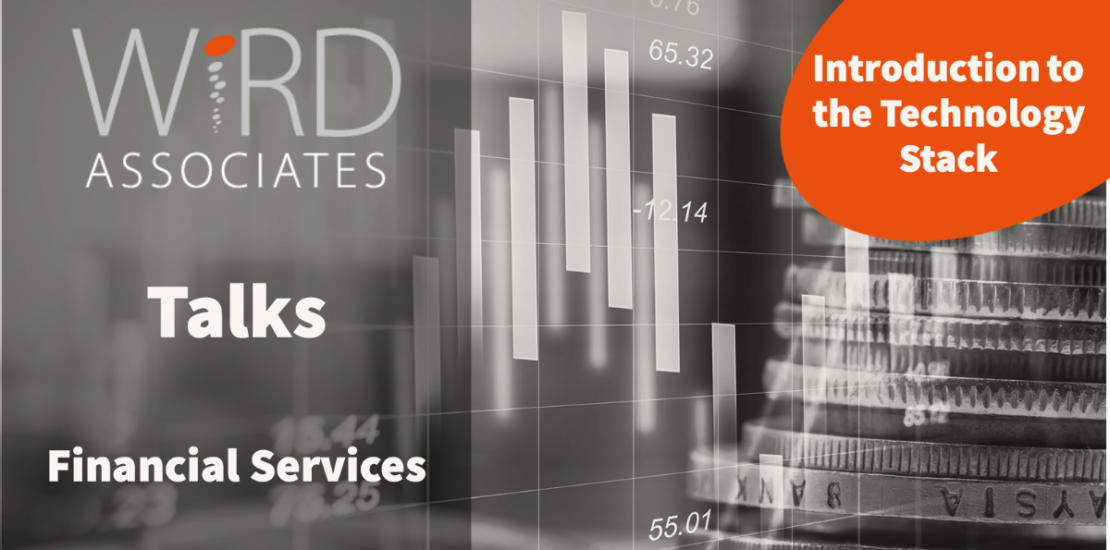- 2023-05-24
- Posted by: Adrian Williams
- Categories: Finance & accounting, IT Architecture, Software

What is the Financial Services Technology stack and why is it important in today’s competitive business environment?
In the fast-paced world of financial services, technology plays a pivotal role in driving innovation, improving operational efficiency, and delivering exceptional customer experiences. The financial services technology stack encompasses a wide range of technologies that empower financial organisations to streamline processes, enhance security, and leverage data-driven insights. In this blog, we will explore some of the key technologies that constitute the financial services technology stack.
The key elements of the Financial Services Technology stack.
The Financial Services Technology stack is made up of a number of key elements. Each element is in turn made up of key technology components. In this blog we will focus on the key elements of the Financial Services Technology stack.
The Core Banking Systems elements of the Financial Services Technology stack: At the heart of every financial institution lies the core banking system. This technology element is responsible for managing key banking functions, including customer accounts, transactions, loans, and deposits. Core banking systems provide a centralised and secure platform for handling financial operations, ensuring accurate record-keeping, and supporting compliance requirements. Modern core banking systems often utilise cloud infrastructure technology components and incorporate API technology components to facilitate integration with other systems and enable seamless data exchange.
The Customer Relationship Management (CRM) elements of the Financial Services Technology stack:Customer Relationship Management (CRM) solutions are vital for financial organisations to manage and nurture customer relationships effectively. CRM platforms consolidate customer data, interactions, and transactions into a unified view, empowering banks to deliver personalised experiences, tailor marketing campaigns, and provide targeted financial advice. Financial organisations leverage CRM technology components to deepen customer engagement, improve cross-selling opportunities, and enhance customer satisfaction.
Risk Management and Compliance elements of the Financial Services Technology stack: Risk management and compliance technologies are crucial in the highly regulated financial services industry. These technologies help organisations assess and mitigate risks, monitor compliance with regulatory requirements, and maintain data privacy and security. The Risk management system technology components used to enable this element of the Technology Stack employ advanced analytics and machine learning algorithms to identify and manage credit, market, operational, and regulatory risks. The resulting Compliance management solutions assist in automating compliance workflows, tracking regulatory changes, and ensuring adherence to industry standards.
Payment Processing and Transactional System elements of the Financial Services Technology stack: Payment processing and transactional systems are the backbone of financial transactions, enabling the seamless movement of funds across various channels. These systems support a wide range of payment options, including credit and debit cards, electronic fund transfers (EFT), mobile payments, and digital wallets. Payment processors are technology components that enable organisations to integrate with banks, payment gateways, and other financial intermediaries to facilitate secure and efficient transactions while ensuring compliance with industry standards and regulations.
Data Analytics and Business Intelligence elements of the Financial Services Technology stack: Data analytics and business intelligence technology components empower financial organisations to harness the power of data for informed decision-making. These tools enable the collection, analysis, and visualisation of large volumes of structured and unstructured data to derive valuable insights. Financial organisations leverage data analytics to identify patterns, detect fraudulent activities, assess customer behaviour, and optimise risk management strategies. The Data Analytics and Business Intelligence elements technology components that support Business intelligence tools provide interactive dashboards and reports, facilitating real-time monitoring and performance tracking.
Cybersecurity and Fraud Prevention elements of the Financial Services Technology stack: In the era of digital finance, the technology components that provide cybersecurity and fraud prevention technologies are critical for safeguarding sensitive customer information and mitigating cyber threats. Financial organisations employ multi-layered security measures, including firewalls, intrusion detection systems, encryption protocols, and identity authentication mechanisms. Advanced fraud detection systems leverage AI and machine learning algorithms to detect and prevent fraudulent activities, ensuring the integrity and trustworthiness of financial transactions.
The financial services technology stack comprises a diverse set of elements and supporting technology components (technologies) that collectively drive the transformation of the industry. From core banking systems to CRM solutions, risk management tools, payment processors, data analytics platforms, and cybersecurity measures, these technologies enable financial organisations to operate efficiently, enhance customer experiences, and navigate the complex regulatory landscape. As the industry continues to evolve, financial organisations must stay abreast of emerging technologies and leverage the appropriate components of the financial services technology stack to stay competitive and deliver exceptional services in the digital age. How important is technology stack innovation to your organisation’s business goals? Please share your experiences with WiRD and each other by commenting or interacting on LinkedIn
